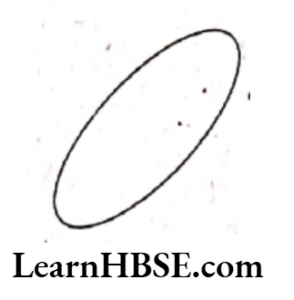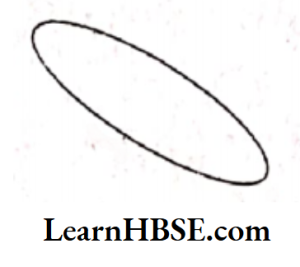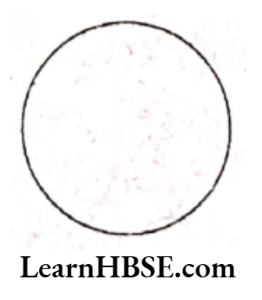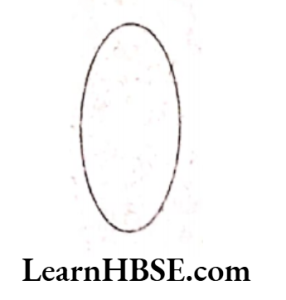Haryana Board Class 7 Maths Solutions For Chapter 13 Visualising Solid Shapes
Key Concepts
- Introduction:
In our day-to-day life, we see several objects around us which have different shapes. One thing common about most of these items is that they all have some length, breadth, and height or depth.
That is they all occupy space and have three dimensions. Hence they are called three-dimensional shapes. - Two-dimensional figures:
The figures drawn on a paper which have only length and breadth are called two-dimensional figures. - Faces, Edges, and Vertices:
The comers of a solid shape are called its vertices. The line segment of its skeleton are its edges. Its flat surfaces are its faces. The 8 corners of the cube are its vertices.
The 12 line segments that form the skeleton of the cube are its edges.
The 6 flat square surfaces that are the skin of the cube are its faces.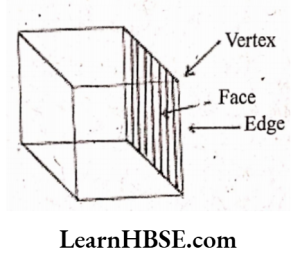
- 2 – dimensional figures
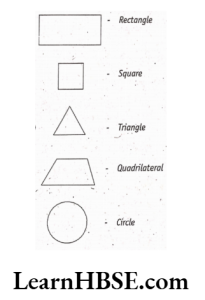
- 3- dimensional figures –
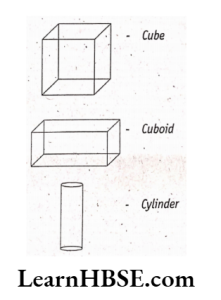
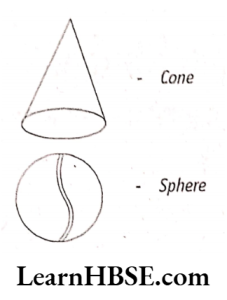

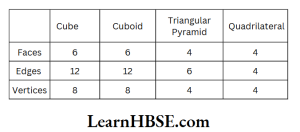
HBSE Class 7 Visualising Solid Shapes Solutions Ex 13.1
Hint: The sum of number of faces and number of vertices – number of edges = 2
i.e, F+V- E = 2
Net: A net is a sort of skeleton outline of a solid that can be folded to make it
- The same solid can have several types of nets.
- Solid shapes can be drawn on a flat surface like paper realistically.
- We call this “2-D representation of a 3-D solid”
- Drawing solids on a flat surface:
- Visual illusion: Our drawing surface is a paper, which is flat. When we draw a. solid shape, the images are somewhat distorted, to make them appear three-dimensional. It is a visual illusion.
- There are two ways of drawing solids on a flat surface. They are
- oblique sketches,
- Isometric sketches.
- Oblique sketches:
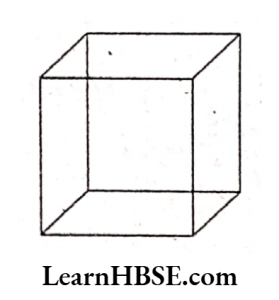
Here is a picture of a cube. It gives a clear idea of how the cube looks like. When seen from the front, We do not see certain faces. In the drawn picture, the lengths are not equal, as they should be in a cube. Such a sketch of a solid is called an “oblique sketch’ - In an oblique sketch, it is clear that.
- The sizes of the front faces and its opposite faces are same.
- The edges which are all equal in a cube, appear so in the sketch, though the actual measures of edges are not taken so.
- Isometric sketches:
Isometric dot sheet is such a sheet which divides the paper into small equilateral triangles made up of dots or lines. To draw sketches, in which measurements also agree with those ofthe solid, we can use isometric dot sheets - Isometric means equal measurements.
- In an isometric sketch, The vertical lines denotes height of the solid and the horizontal lines generally drawn at 30° to the baseline to denote length and width.
- A shadowplay:
- Another way is by observing a 2-D shadow of a 3-D shape.
- A third way is to look at the shape from different angles. The ‘front’ view, the side view’ and the ‘top view’ can provide a lot of information about the shape observed.
Haryana Board Class 7 Maths Visualising Solid Shapes solutions
Solutions To Try These
Match the shape with the name:
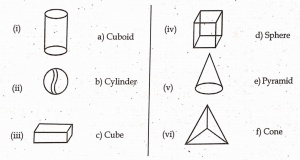
Solution. (i)- b (11)- d (iii)- a (iv) – c (v) – f (vi) – e
Solutions To Try These
Match the 2-dimensional figures with the names:
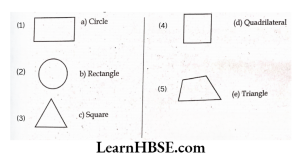
Solution:
(1) – b (2) – a (3) – e (4)- c (5)- d
Solutions For Pratice
Complete the following table:
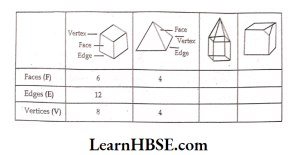
Solution:
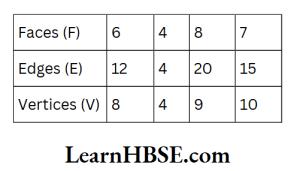
Solutions To Try These
Here youfind four nets. There are two correct nets among them to make a tetrahedron. See if you can work out which nets will make a tetrahedron.
Solution:

(1) and (2) are the correct nets for making a tetrahedron
Haryana Board Class 7 Maths Solutions For Chapter 13 Exercise 13.1
1. Identify make cubes the nets(cut out which copies can of be the used nets to a and try it):

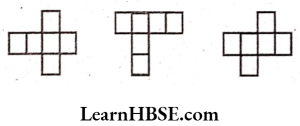
Solution: Nets (2), (3),(4) and (5) can be used to make cubes.
2) Dice are cubes with dots on each face. Opposite faces of a die always have a total of neven dots on them.
Here are two nets to make dice (cubes). the numbers inserted in each square indicate the number of dots in that box.
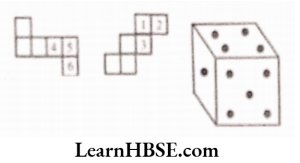
Insert suitable numbers in the blanks, remembering that the number on the opposite faces should total to 7.
Solution:
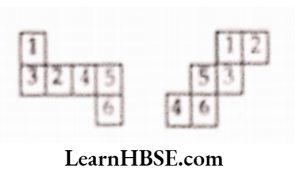
HBSE 7th Class Visualising Solid Shapes Real-Life Applications
3. Can this be a net for a die?
Explain your answer.
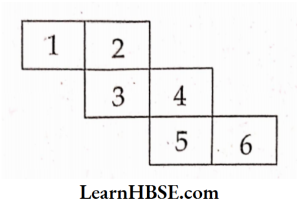
Solution:
No, we cannot use the given net as a die Because one pair at opposite face will have 1 and 4 on them whose total is not equal to 7 and another pair of opposite faces will have 3 and 6 on them whose total is also not equal to 7.
HBSE Class 7 Visualising Solid Shapes Chapter 13 Definitions Faces Edges Vertices
4. Here is an incomplete net to making a cube. Complete it in at least two different ways. Remember that a cube has six faces. How many are there in the net here? (Give two separate diagrams. If you like, you may use a squared sheet for easy manipulation )
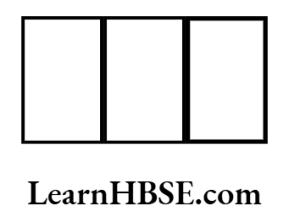
Solution:
To complete the net for making a cube in at latest two different ways Such that a cube has six faces as follows:
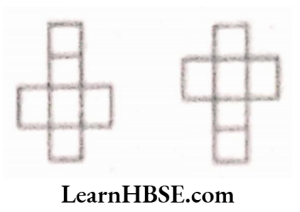
It is clear that there are three faces in the net.
How to draw 3D shapes on paper Class 7 HBSE
5. Match the nets with appropriate Solids
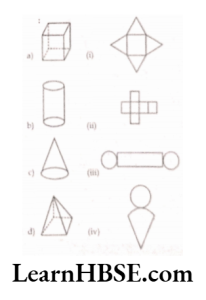
Solution: a -(2); b -(3) ;c – (4); d)- (1)
Haryana Board Class 7 Maths Solutions For Chapter 13 Exercise-13.2
1. Use isometric dot paper and make an isometric sketch for each one of the given shapes:
(1)
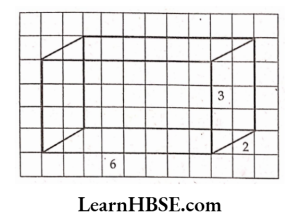
Top Front Side Views of Solids Class 7 Haryana Board
(2)
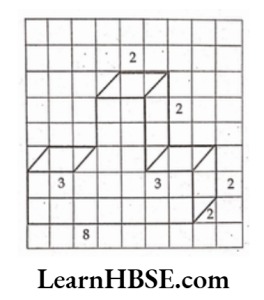
(3)
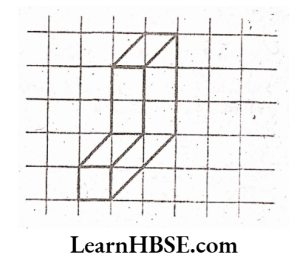
(4)
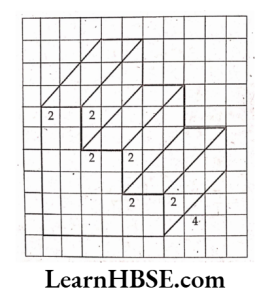
Solution:
(1)
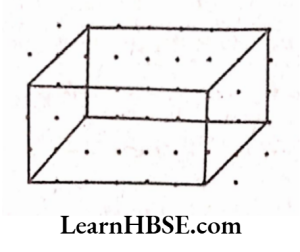
(2)
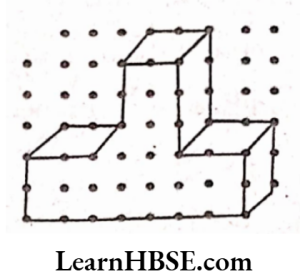
(3)
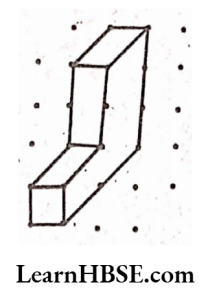
Faces, edges, and vertices of 3D shapes Class 7 HBSE
(4)
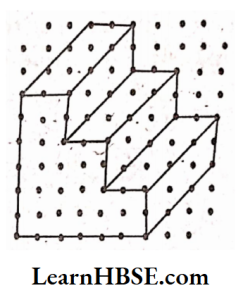
2. The dimensions of a cuboid are 5 cm, 3cm and 2 cm. Draw three different isometric sketches of this cuboid.
Solution:
(1)
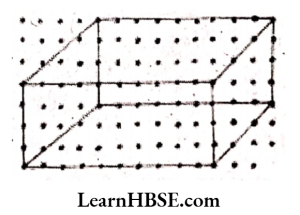
(2)
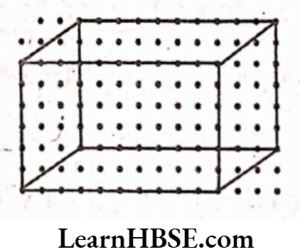
(3)

The above are the three different isometric sketches of cuboid of dimensions 5 cm, 3 cm and 2 cm. By changing length, breadth andheight we get the above sketches.
Drawing Oblique Sketches Class 7 HBSE Solutions
3. Three cubes each with 2 cm edge are placed side by side to form a cuboid. Sketch an oblique or isometric sketch of this cuboid.
Solution: Three cubes each with 2 cm edge are placed side by side to form a cuboid then
length = 2 + 2 + 2 = 6cm
Breadth = 2 cm
Height = 2 cm
Oblique sketch of the cuboid:
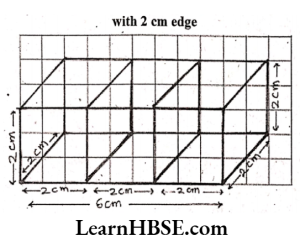
Isometric sketch of the cuboid :
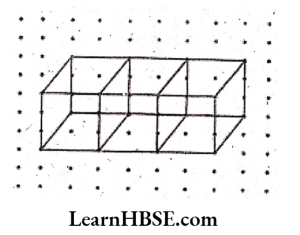
4. Make an oblique sketch for each one of the given isometric shapes.

Solution: Oblique sketch:
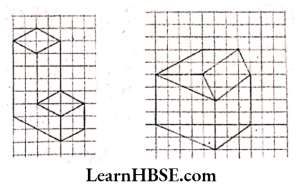
5. Give (1) an oblique sketch and (2) an isometric sketch for each of the following:
1) A cuboid of dimensions 5 cm, 3 cm and 2 cm. (Is your sketch unique?)
2) A cube with an edge 4 cm long.
Solution:
(1) Oblique sketches:
1)
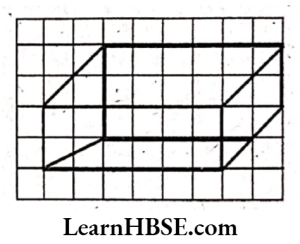
2)
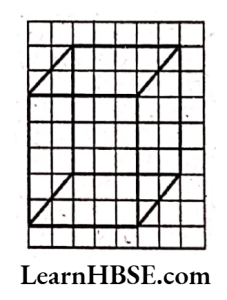
(2) Isometric sketches:
1)
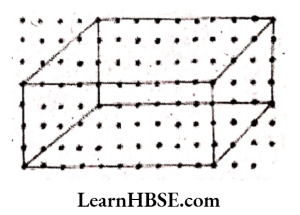
2)
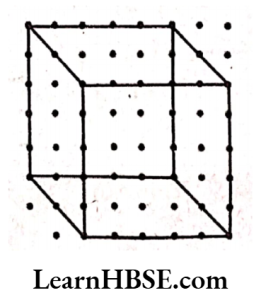
Nets of solid shapes examples Class 7 HBSE
Solutions To Try These
Try to guess the number of cubes in the. following arrangements:

Solution:
The number of cubes in the arrangements are :
(1) 24 cubes (2) 8 ctibes (3) 9 cubes
Solutions To Try These
1. Two dice are placed side by side as shown: Can you say what the total would be on the face opposite to
1) 5 + 6
2) 4 + 3
(Remember that in a die sum of the numbers on opposite faces is 7).
Solution:
Numbers on the opposite face
1) 5 + 6 is 2 + 1
2) 4 + 3 is 3 + 4
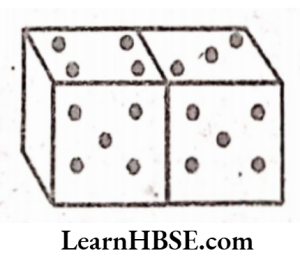
2. Three cubes each with 2 cm edge are $ § § placed side by side to form a cuboid. Try to make an oblique sketch and say what could be its length, breadth and height.
Solution:
Length = 2 cm + 2 cm + 2 cm = 6 cm
Breadth = 2 cm
Height =2 cm
Haryana Board Class 7 Maths Solutions For Chapter 13 Exercise-13.3
1. What cross-sections do you get when you give a
(1) vertical cut (2) horizontal cut to the following solids?
1) A brick; 2) A round apple 3) A die 4) A circular pipe 5) An ice cream cone
Solution:
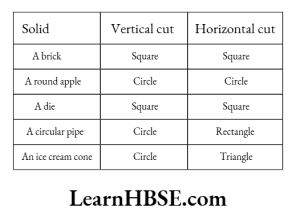
Haryana Board Class 7 Maths Solutions For Chapter 13 Exercise-13.4
1. A bulb is kept binning just above the following solids. Name the shape of the shadows obtainedin each case. Attempt to give a rough sketch of the shadow. (You may try to experiment first and then answer these questions)

(1) A ball (2) A cylindrical pipe (3) A book
Solution:
1)
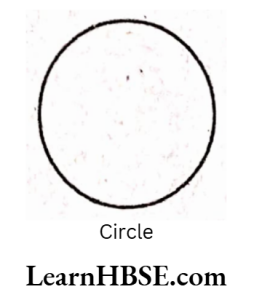
2)
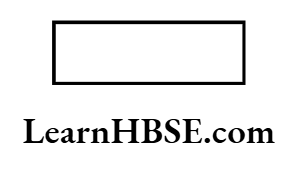
3)
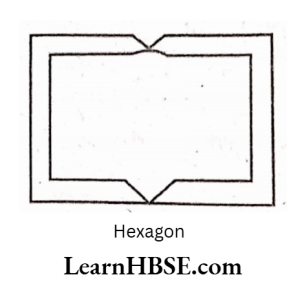
2. Here are shadows of some 3-D objects, when seen under the lamp of an overhead projector. Identify the solid(s) that match each shadow. (There may be multiple answers for these !)

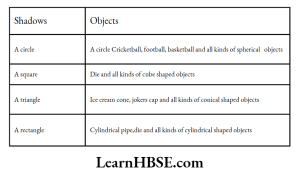
3. Examine if the following are true statements:
(1) The cube can cast a shadow in the shape of a rectangle.
(2) The cube can cast a shadow in the shape of a hexagon
Solution: (1) True (2) False
Solutions To Try These
1. For each solid, the three views (1), (2), (3) are given. Identify for each solid the corresponding top, front, and side views.
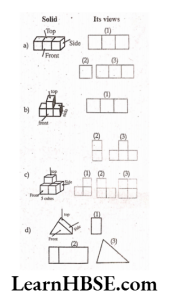
Solution:
1) 1 -> Front 2 -> Side 3 -> Top
2) 1 -> Top 2 -> Side 3 -> Front
3) 1 -> Side 2 -> Front3 -> Top
4) 1 -> Side 2 -> Top 3 -> Front
HBSE Class 7 Maths Chapter 13 Guide Visualising Solid Shapes
2. Draw a view of each solid as seen from the direction indicated by the arrow.
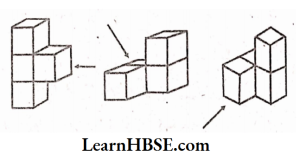
Solution:
View of solid as seen from the direction indicated by the arrow:
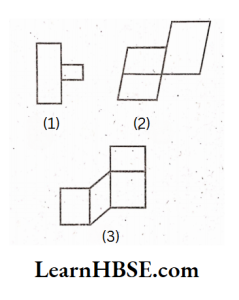
Haryana Board Class 7 Maths Solutions For Chapter 13 Very Short Answer Questions!
1. Give examples of ‘plane figures’
Solution:
The circle, the square, the rectangle, the quadrilateral, and the triangle.
2. Give examples of ‘solid shapes’.
Solution:
The cube, the cuboid, the sphere, the cylinder, the cone, and the pyramid.
3. How many types of sketches of a solids are possible? What are they?
Solution:
There are-two types of sketches of a solid that are possible. They are (1) Oblique sketches (2) Isometric sketches.
Key Questions in Visualising Solid Shapes for Class 7 HBSE
4. What shape is (1) A brick (2) A road roller (3) A sweet laddu
Solution:
(1) A brick- Cuboid
(2) A road roller- Cylinder
(3) A sweet laddu – Sphere
Different views of solid shapes Class 7 Haryana Board
5. Give two examples of the following
(1) Cone (2) Cylinder (3) Cuboid
Solution:
(1) Cone- Ice cream cone; birthday cap
(2) Cylinder – Pillar, road roller
(3) Cuboid- Book, matchbox
6. Write the difference between an oblique sketch and an isometric sketch.
Solution:
An oblique sketch:
It does not have proportional lengths. Still it conveys all important aspects of the appearance of the solid.
An isometric sketch:
It is drawn on an isometric dot paper. In anisometric sketch of the solid the measurements are of exact size.
Haryana Board Class 7 Maths Solutions For Chapter 13 Short Answer Questions
7. Write names of at least 2 objects from day-to-day life, which arc in the shape of the basic 3D shapes given below:
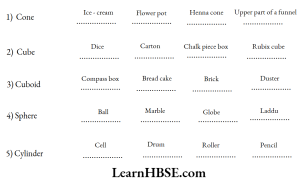
Haryana Board Class 7 Maths Solutions For Chapter 13 Long Answer Questions
8. Given below are the pictures of some objects. Categorise and write their names according to the shape and fill the table with name of it.
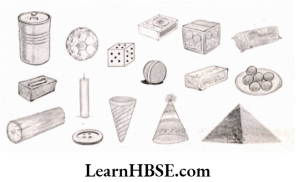
Solution:
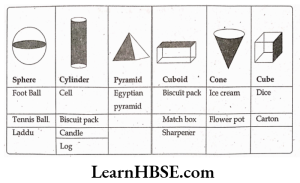
9. Use an isometric dot paper and make an isometric sketch for each one of the given shapes.
1)
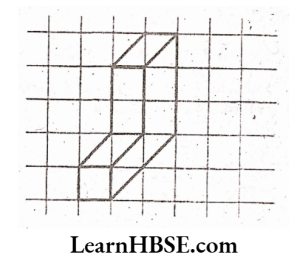
2)
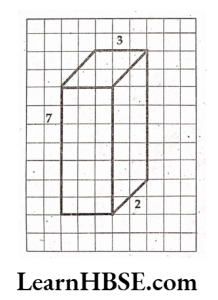
3) 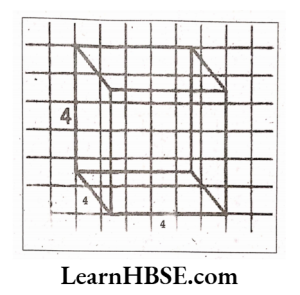
Solution:
1) Isometric sketch for the given shape

2) Isometric sketches for the figure given

3) Isometric sketches for the figure given
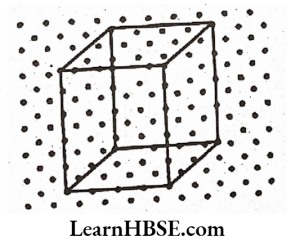
Important Concepts Visualising Solid Shapes Class 7 HBSE
10. The dimensions of a cuboid are 5 cm, 3 cm and 2 cm. Draw two different isometric sketches of this cuboid.
Solution: The two different isometric sketches of the cuboid whose dimensions are 5 cm, 3 cm and 2 cm. are
1)
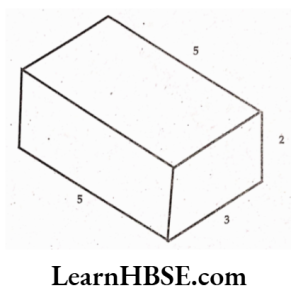
2)
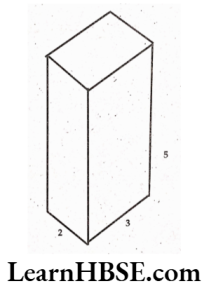
11. Three cubes each with 2 cm edge are placed side by side to form a cuboid. Draw an oblique or isometric sketch of this cuboid.
Solution:
Three cubes each with 2 cm edge are placed side by side to form a cuboid;
1) The oblique sketch of thus formed cuboid
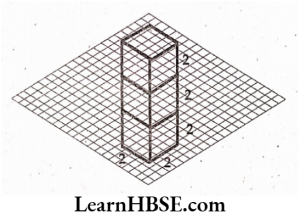
2) Isometric sketch of cuboid.
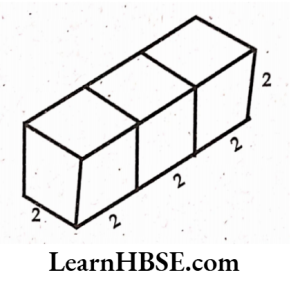
Haryana Board Class 7 Maths Solutions For Chapter 13 Multiple Choice Answer Questions
1. Match the following.
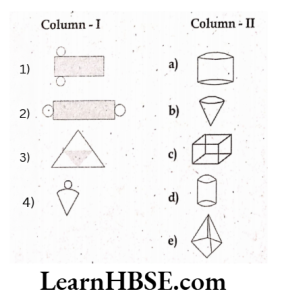
- 1- a,2 – d,3 – e, 4-b
- 1 – b,2- c,3 – d,4- e
- 1 – a,2- c,3 – d,4 -b
- 1 – c,2- d,3 – a,4-b
Answer: 1
Practice Problems Visualising Solid Shapes Class 7 Haryana Board with Nets of Solids
2. What is the number on the face opposite to 4 on a die?
- 5
- 1
- 3
- 2
Answer: 3
3. What is the horizontal cross-section of cone?
- Circle
- Right triangle
- Rectangle
- Square
Answer: 1
4. What is the vertical cross-section of cone?
- Circle
- Right triangle
- Rectangle
- Square
Answer: 2
5. When we rotate a right triangle we get a
- Cube
- Cuboid
- Cone
- Cylinder
Answer: 3
6. The solid with one curved surface and one flat surface is……..
- Cuboid
- Cylinder
- Cone
- Sphere
Answer: 3
7. When we cut a brick horizontally then the shape of the cutting is……..
- Square
- Rectangle
- Triangle
- Circle
Answer: 2
You can draw sketches in which measurements also agree with those of a given solid. To do this we need anisometric sheet.
Read the above para and answer the following (8-9).
8. What is the difference between oblique sketch and isometric sketch?
- Shape
- Faces
- Measurements
- None
Answer: 3
9. Ravi wants to draw 6 cm, 3 cm, and 2 cm cuboid exactly with these measurements. Which method is suitable?
- Oblique sketch
- Isometric sketch
- Kitchen play
- Shadow play
Answer: 2
10. Nani cuts the carrot as shown in figure. What is the shape of cross-section?
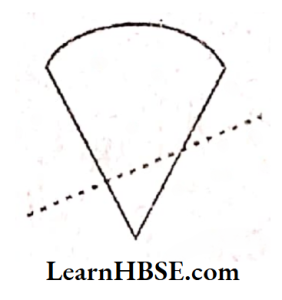
Answer: 1
11. Pyramid is a ……dimensional object.
- 1
- 2
- 3
- Infinite
Answer: 3
12. A point has…….. dimensions.
- 1
- 2
- 3
- ‘0’ (zero)
Answer: 4
13. A two-dimensional figure in the following is
- Ball
- Square
- Cylinder
- Matchbox
Answer: 2
14. A three-dimensional figure in the following is
- Ball
- Square
- Rectangle
- Triangle
Answer: 1
15. Can this be a net for a cube?
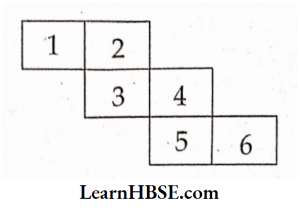
- Yes
- No
- Sometimes
- None
Answer: 2
16. Which of the following is not the net of a cube?
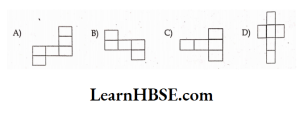
Answer: A
17. Identify the correct statement
- A cube has 8 vertices
- A cuboid has 10 faces
- A cone has 2 vertices
- A cylinder has vertex
Answer: 1
18. One face of a dice has 3 dots then its opposite face contains……..number of dots.
- 3
- 4
- 5
- 1
Answer: 2
19. Which solid has four triangular faces and one square face?
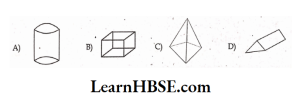
Answer: C
20.  is the net diagram of the following
is the net diagram of the following
- cylinder
- triangular pyramid
- cube
- square pyramid
Answer: 2
21. The top view of the cylinder is…………..

Answer: A
22. Rishi made a cube of side 3 cm with a wire. What is the length of the wire?

- 32 cm
- 42 cm
- 48 cm
- 36 cm
Answer: 4
23. The following is the shadow of which 3D object?
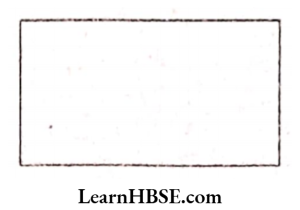
- sphere
- cylinder
- cuboid
- cone
Answer: 3
24. The diagram represents the front view of…………..

- die
- book
- ball
- pyramid
Answer: 4
25. The solid which has square shaped from front, top view and side view is
- cuboid
- cylinder
- cube
- cone
Answer: 3
26. The following has only one flat surface

Answer: A
27. What is the shape Of resulting figure of the combination of two cubes?
- rectangle
- cuboid
- cylinder
- cone
Answer: 2
28. The number of vertices of the figure
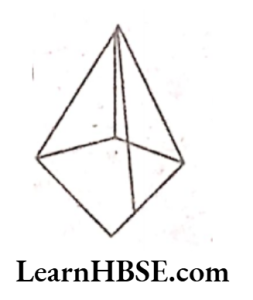
- 4
- 5
- 6
- 7
Answer: 2
29. The net of cylinder is …………

Answer: B
30. How many cubes are there in the figure?
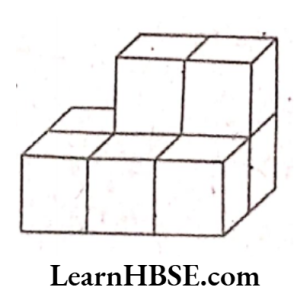
- 6
- 8
- 10
- 12
Answer: 2
31.  What are the measurements of resulting figure?
What are the measurements of resulting figure?
- l = 6 cm, b = 3 cm, h = 3 cm
- l = 3 cm, b = 3 cm, h = 6 cm
- l = 3 cm, b = 6 cm, h = 3 cm
- l = 6 cm, b = 6 cm, h = 6 cm
Answer: 1
32. Relavent 3D shape of the net
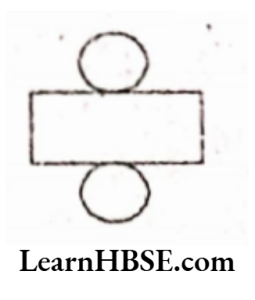

Answer: A
Haryana Board Class 7 Maths Solutions For Chapter 13 Fill in the blanks:
33. Plane figures are of……………
Answer: two dimension
34. ……….shapes are of three dimensions.
Answer: Solid
35. The corners of a solid shape are called……..
Answer: vertices
36. The line segments that forms the skeleton of the cube are its……..
Answer: edges
37. The flat surfaces that are the skin of the cube are its………
Answer: faces
38. A …….is a skeleton outline of a solid that can be folded to make it.
Answer: net
39…………is a very useful skill.
Answer: Visualising solid shapes
40. A cylinder has …….faces.
Answer: 2
41. The vertical cut of a circular pipe is a ………..
Answer: circle
42. Ball and laddu are examples for a ……….shape.
Answer: sphere
Shape No. of faces or edges
43. Match the following:
Shape No Of Faces Or Edges
1. Cube ( ) A) 4
2. Triangular pyramid ( ) B) 12
3. Triangular prism in the shape of a kaleidoscope ( ) C) 6
4. Number of edges in a cuboid ( ) D) 8
5. Number of verticesin a cuboid ( ) E) 5
Answer:
1. C 2. A 3. E 4. B 5. D

